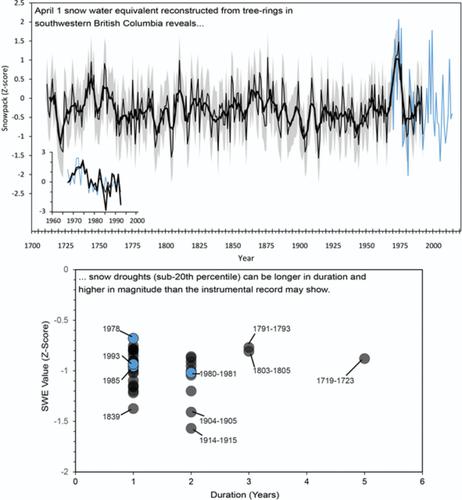当前位置:
X-MOL 学术
›
Hydrol. Process.
›
论文详情
Our official English website, www.x-mol.net, welcomes your
feedback! (Note: you will need to create a separate account there.)
Three hundred years of snowpack variability in southwestern British Columbia reconstructed from tree‐rings
Hydrological Processes ( IF 2.8 ) Pub Date : 2020-10-08 , DOI: 10.1002/hyp.13933 Bryan J. Mood 1 , Bethany Coulthard 2 , Dan J. Smith 1
Hydrological Processes ( IF 2.8 ) Pub Date : 2020-10-08 , DOI: 10.1002/hyp.13933 Bryan J. Mood 1 , Bethany Coulthard 2 , Dan J. Smith 1
Affiliation

|
Recent snow droughts in southwestern British Columbia (BC), Canada, have reduced seasonal streamflow during the typically dry late‐spring and summer months, leading to socio‐economic and ecological impacts that draw attention to the impending consequences of climate change. Knowledge of annual winter snowfall variability within this region is largely derived from a sparse network of short‐duration (≤50 years) snow survey stations. In this paper, we develop an annual April 1 snow water equivalent (SWE) reconstruction from living tree‐ring chronologies that offer a perspective on long‐term natural snowpack variability. The dendrohydrological model estimates the first principal component April 1 SWE for the southwestern regions of BC to 1711. Spectral analysis identified dominant multidecadal April 1 SWE variability over the pre‐instrumental period. The reconstruction successfully captures known instrumental period influences of La Niña oscillations on reconstructed SWE, suggesting that our tree‐ring based the reconstruction has the potential to provide insights on pre‐instrumental ocean–atmosphere links with southwestern BC snowpack dynamics. Runs analysis suggests pre‐instrumental snow droughts have been more than twice as long in duration and severity than during the observed period which indicates the instrumental record may not capture the full range of April 1 SWE variability. The reconstruction provides the first high‐resolution description of SWE over the past 300 years in southwestern BC and is of immediate use to regional water resource managers.
中文翻译:

从树木年轮重建不列颠哥伦比亚省西南部三百年的积雪变化
加拿大不列颠哥伦比亚省西南部地区最近的雪灾,在通常干燥的春末和夏季,减少了季节性流量,导致了社会经济和生态影响,引起人们对气候变化即将发生的后果的关注。该地区每年降雪量的年度变化知识主要来自短时(≤50年)降雪测量站的稀疏网络。在本文中,我们从树木年轮的年表中展开了每年4月1日的雪水当量(SWE)重建工作,从而提供了长期自然雪堆变化的观点。树状水文模型估算了卑诗省西南地区至1711年4月1日SWE的第一个主要成分。光谱分析确定了仪器前期占主导地位的年代际4月1日SWE的变异性。重建成功地捕获了拉尼娜振荡对重建的SWE的已知仪器周期影响,这表明我们基于树环的重建有潜力提供与西南BC积雪动力学相关的前仪器海洋与大气联系的见识。运行分析表明,仪器前的积雪干旱的持续时间和严重程度是观测期间的两倍以上,这表明仪器记录可能无法捕获4月1日SWE变异的全部范围。重建为卑诗省西南地区300年来的SWE首次高分辨率描述,可立即用于区域水资源管理者。这表明我们基于树环的重建有可能提供关于仪器前海洋与西南卑诗省积雪动力学的联系的见解。运行分析表明,仪器前的积雪干旱的持续时间和严重程度是观测期间的两倍以上,这表明仪器记录可能无法捕获4月1日SWE变异的全部范围。重建为卑诗省西南地区300年来的SWE首次高分辨率描述,可立即用于区域水资源管理者。这表明我们基于树环的重建有可能提供关于仪器前海洋与西南卑诗省积雪动力学的联系的见解。运行分析表明,仪器前的积雪干旱的持续时间和严重程度是观测期间的两倍以上,这表明仪器记录可能无法捕获4月1日SWE变异的全部范围。重建为卑诗省西南地区300年来的SWE首次高分辨率描述,可立即用于区域水资源管理者。运行分析表明,仪器前雪旱灾的持续时间和严重程度是观测期间的两倍以上,这表明仪器记录可能无法捕获4月1日SWE变异的全部范围。重建为卑诗省西南地区300年来的SWE首次高分辨率描述,可立即用于区域水资源管理者。运行分析表明,仪器前的积雪干旱的持续时间和严重程度是观测期间的两倍以上,这表明仪器记录可能无法捕获4月1日SWE变异的全部范围。重建为卑诗省西南地区300年来的SWE首次高分辨率描述,可立即用于区域水资源管理者。
更新日期:2020-12-10
中文翻译:

从树木年轮重建不列颠哥伦比亚省西南部三百年的积雪变化
加拿大不列颠哥伦比亚省西南部地区最近的雪灾,在通常干燥的春末和夏季,减少了季节性流量,导致了社会经济和生态影响,引起人们对气候变化即将发生的后果的关注。该地区每年降雪量的年度变化知识主要来自短时(≤50年)降雪测量站的稀疏网络。在本文中,我们从树木年轮的年表中展开了每年4月1日的雪水当量(SWE)重建工作,从而提供了长期自然雪堆变化的观点。树状水文模型估算了卑诗省西南地区至1711年4月1日SWE的第一个主要成分。光谱分析确定了仪器前期占主导地位的年代际4月1日SWE的变异性。重建成功地捕获了拉尼娜振荡对重建的SWE的已知仪器周期影响,这表明我们基于树环的重建有潜力提供与西南BC积雪动力学相关的前仪器海洋与大气联系的见识。运行分析表明,仪器前的积雪干旱的持续时间和严重程度是观测期间的两倍以上,这表明仪器记录可能无法捕获4月1日SWE变异的全部范围。重建为卑诗省西南地区300年来的SWE首次高分辨率描述,可立即用于区域水资源管理者。这表明我们基于树环的重建有可能提供关于仪器前海洋与西南卑诗省积雪动力学的联系的见解。运行分析表明,仪器前的积雪干旱的持续时间和严重程度是观测期间的两倍以上,这表明仪器记录可能无法捕获4月1日SWE变异的全部范围。重建为卑诗省西南地区300年来的SWE首次高分辨率描述,可立即用于区域水资源管理者。这表明我们基于树环的重建有可能提供关于仪器前海洋与西南卑诗省积雪动力学的联系的见解。运行分析表明,仪器前的积雪干旱的持续时间和严重程度是观测期间的两倍以上,这表明仪器记录可能无法捕获4月1日SWE变异的全部范围。重建为卑诗省西南地区300年来的SWE首次高分辨率描述,可立即用于区域水资源管理者。运行分析表明,仪器前雪旱灾的持续时间和严重程度是观测期间的两倍以上,这表明仪器记录可能无法捕获4月1日SWE变异的全部范围。重建为卑诗省西南地区300年来的SWE首次高分辨率描述,可立即用于区域水资源管理者。运行分析表明,仪器前的积雪干旱的持续时间和严重程度是观测期间的两倍以上,这表明仪器记录可能无法捕获4月1日SWE变异的全部范围。重建为卑诗省西南地区300年来的SWE首次高分辨率描述,可立即用于区域水资源管理者。











































 京公网安备 11010802027423号
京公网安备 11010802027423号